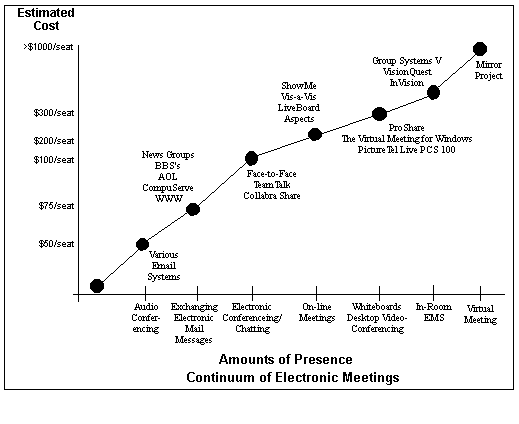This has led to the development of many new and innovative network applications and has also caused immense demand for high-speed and ubiquitous Internet access, in both corporate and residential environments. Three important consequences of this trend are:
- The development of corporate intranets,
- The development of several alternatives for residential Internet access, and
- The development of wireless technologies for network access.
What is an intranet? While there is no standard an accepted definition
of this term, it is essentially a collection of computers and networks
within a (possibly global) organisation, connecting the organisation's
members to a range of computer services, resources, and information.
Despite having heterogeneous machines on many physically distinct and
distant networks, the software and tools on the network provide the
appearance of a single, large, homogeneous network, and enable efficient
communication and collaboration between employees. One example
specification is Netscape's vision
of the
Full Service Intranet.
Clearly, the development of intranets, which has also been triggered by
increasing awareness in organizations of
the value of collaboration and horizontal integration, is an important
catalyst for the spread of collaborative applications and technologies.
In addition to intranets, extranetsinter-organizationalIntranets
In the office environment, many corporate and educational institutions
are starting to move from the conventional 10 Mbps shared Ethernet and
(sometimes) FDDI technologies towards switch-based, high-speed Local
Area Networks(LANs) ranging from 100 Mbps switched Ethernets to
higher-speed Gigabit Ethernets. Asynchronous Transfer Mode (ATM) does
not seem to be living up to its earlier promise (made in many circles)
of being the panacea to all bandwidth-related ills for integrated data
and voice/video services in that it isn't the technology of choice for
LANs; however, it is likely to play an important role in the backbones
of large scale corporate networks as well as the Internet. One
consequence of this is the emergence of medium- to large-scale corporate
intranets. Residential Access
In addition to increasing speeds of conventional modems over telephone
lines (which have inherent limitations in how fast they can go),
technologies for high-speed residential Internet access, such as 128
Kbps Integrated Services Digital Network (ISDN), Asymmetric Digital Subscriber Loop (ADSL),
cable modems, and Direct Broadcast Satellite (DBS), are
being developed and are in various stages of deployment around the
world.
In an earlier project, we have found that most residential network access technologies are inherently asymmetric in nature. Depending on the exact details of the system, the ratio of bandwidth in the "forward" (towards the client) to "reverse" (away from the client) could be anywhere between 10 to 1000. The reasons for the development of asymmetric access technologies, such as ADSL and cable modems have to do with the fact that it is a lot easier and cheaper to provide higher "downstream" bandwidths than in the "upstream" direction. Upstream connectivity is provided either by means of conventional dialup phone lines or lower-bandwidth, higher-contention cable lines. The push toward asymmetric technologies for home use is not simply a consequence of technology -- it is also motivated by the nature of traffic in today's most popular network application -- Web access. Most Web sessions involve the transfer of far more data towards the client than away from it; the return channel is used mainly for Web requests, forms, and of course, TCP acknowledgments of received data.
However, the continuing deployment of highly asymmetric access
technologies implies that applications that involve more symmetric data
transfer, such as symmetric video conferencing, would not achieve
particularly good performance, especially in the upstream direction.
Even the best compression algorithms known today need at least 128 Kbps
for acceptable conferencing performance to provide the participants with
the required sense of presence. This affects the level of participation
telecommuters can achieve and make their presence felt in meetings that
they participate in from home.
Wireless Technologies
In the recent past, there has been a proliferation of wireless network
access technologies, both in research labs and in the
commercial marketplace. Available technologies include both local-area
and wide-area ones. Local-area technologies include in-room ones based
on infra-red and in-building ones based on spread-spectrum
technologies, and have bandwidths between 1-4 Mbits/s. Wide-area
wireless networks, such as Metricom's
Ricochet have higher range than LAN wireless networks, but
substantially lower bandwidths (30-100 Kbits/s). They are therefore not
suitable for applications like video conferencing, although two-way
audio and shared whiteboards work quite well.
Our interest in wireless is primarily at the LAN end of the spectrum,
and particularly on how it can be used in conjunction with a network
computer to provide ubiquitous network connectivity and enhance
collaborative activities in office environments (e.g., hospitals,
factory floors, etc.). An example of the sort of product we are talking
about here is U.C. Berkeley's Infopad research prototype,
which is a wireless multimedia terminal coupled with backbone network
and application support that provides real-time multimedia conferencing
capabilities.
The trend towards increasing network bandwidths and ubiquitous network access augurs well for collaborative and conferencing applications, especially ones that involve real-time multimedia dissemination. Improving network hardware, coupled with improvements in routing and data transport technologies (e.g., multicast) as well as conferencing software tools, are opening up the possibilities of large-scale collaborative applications on the Internet. In the remainder of this section, we discuss these issues.
IP Multicast and the MBone
Multicast is an efficient way by which distributed applications
can achieve point-to-multipoint or multipoint-to-multipoint
communication and data transfer without unnecessary and redundant
replication of packets in the network, using bandwidth and network
resources efficiently. IP multicast is the collective name given
to the routing protocols that support multicasting over IP on the
Internet. The Multicast Backbone, or the MBone as it is called,
is the multicast-enabled virtual network that is laid over the
traditional (unicast) Internet for multicast applications.
Collaborative and conferencing applications are some of the main
beneficiaries of multicast, and indeed, such applications were the main
reasons for the development and recent proliferation of this
technology. The MBone has grown substantially in its relatively short
lifetime from its inception in 1988. Today, there are over 3000
multicast-enabled subnets in the world, and this number is increasing
with time. A topology map of the MBone as of August 1996 may be
obtained from here.
Some interesting information about the history and future of the MBone,
IP multicast, and conferencing applications can be obtained from this interview with Steve
Deering, one of the pioneers of the IP multicast infrastructure.


 Case Studies
Case Studies Overview of Trends
Overview of Trends Contents
Contents